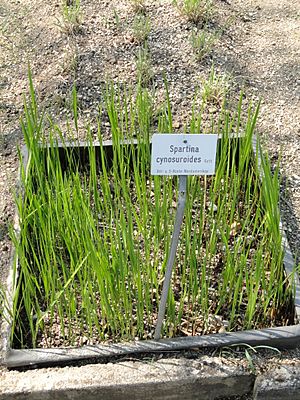Big cordgrass facts for kids
Quick facts for kids Big cordgrass |
|
|---|---|
 |
|
| Botanical garden specimen | |
| Conservation status | |
| Scientific classification | |
| Kingdom: | |
| (unranked): | |
| (unranked): | |
| (unranked): | |
| Order: | |
| Family: | |
| Genus: |
Spartina
|
| Species: |
S. cynosuroides
|
| Binomial name | |
| Spartina cynosuroides (L.) Roth
|
|
Spartina cynosuroides is a type of grass known by the common names big cordgrass and salt reedgrass. It grows naturally along the East Coast and Gulf Coast of the United States. You can find it in coastal areas like marshes, lagoons, and bays.
What is Big Cordgrass?
Big cordgrass is a special kind of grass that lives for many years. It grows from underground stems called rhizomes. These rhizomes help the plant spread and grow in tough environments. This grass can grow very tall, sometimes reaching up to 10 feet (about 3 meters)!
How to Spot Big Cordgrass
The leaves of big cordgrass can be up to 24 inches (about 60 cm) long and an inch (about 2.5 cm) wide. At the bottom, the stem can be about ¾ of an inch (nearly 2 cm) thick. Near the base of the leaves, there's a small, hairy flap called a ligule. The plant also has a flower part called an inflorescence. This part can have up to 40 spikes, each up to 3 inches (about 7.5 cm) long.
Where Big Cordgrass Lives
This grass loves to grow in salty, wet soils. You'll often find it in salt marshes, which are coastal wetlands flooded by salty water. It often grows alongside other marsh plants like marsh-hay cordgrass (Spartina patens) and common reed (Phragmites australis).


